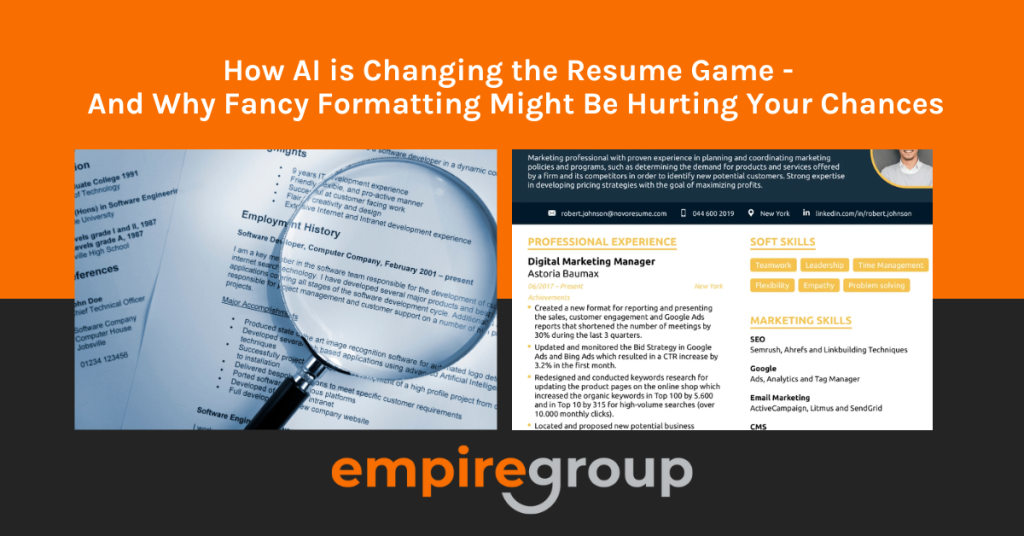How AI is Changing the Resume Game – And Why Fancy Formatting Might Be Hurting Your Chances
AI is changing the CV Game
A friend recently came to me, frustrated that they weren’t progressing in their job applications. When I saw their “fandangle” resume—full of text boxes, graphics, and elaborate designs—it became clear why. They had spent hours perfecting a visually stunning document, thinking it would help them stand out. But when they kept getting radio silence from recruiters, it was clear their resume was likely being rejected by applicant tracking systems (ATS) before a human even saw it.
The world of recruitment has changed significantly in the last decade. With the rapid adoption of artificial intelligence (AI) and ATS, hiring teams can now process thousands of applications more efficiently than ever. While AI has helped speed up the longlisting process and reduce time-to-hire, it has also introduced new challenges for candidates. One of the biggest pitfalls? Overly designed resumes that AI struggles to read.
The role of AI in resume screening
To streamline recruitment processes, many organisations are leveraging AI-powered tools to sift through resumes quickly. These systems scan applications for keywords, skills, experience levels, and other relevant criteria, identifying the most suitable candidates for further review.
This shift means recruiters no longer manually review every application; instead, AI filters out candidates who don’t meet the baseline criteria, allowing hiring managers to focus on the best-fit individuals. While this automation significantly improves efficiency, it also means that if your resume isn’t formatted correctly, you could be eliminated before a human ever sees it.
How resume formatting can work against you
Many job seekers put a lot of effort into designing visually appealing resumes, using tables, text boxes, graphics, and creative layouts to stand out. However, most AI-driven ATS are not advanced enough to read content within these elements.
Here’s why is a problem for Resumes for AI-driven ATS’:
- Text boxes & tables: Many ATS systems struggle to extract text from within tables or text boxes. If you’ve placed your work experience or key skills inside a box, there’s a chance the system won’t read it at all.
- Graphics & icons: While they may enhance aesthetics, AI cannot interpret graphical elements, meaning important information embedded within them could be missed.
- Headers & footers: Some ATS tools overlook content placed in headers and footers, potentially omitting key contact details.
- Fancy fonts & formatting: Non-standard fonts or complex layouts may not parse correctly, leading to jumbled or unreadable resumes.
Optimising your resume for AI & ATS
To ensure your resume gets past the initial AI screening, follow these best practices:
- Use standard formatting: Stick to a clean, simple layout using standard fonts (Arial, Calibri, Times New Roman) and font sizes between 10-12 pt.
- Avoid tables & text boxes: Instead, structure your content using clear headings and bullet points.
- Use keywords thoughtfully: AI tools scan for job-relevant keywords, so ensure your resume naturally includes industry-specific terminology found in the job description.
- Submit in the right format: While PDFs are widely accepted, some older ATS systems struggle to read them. If in doubt, submit a Word document (.docx) unless instructed otherwise.
- Test your resume: Before submitting, try converting it into plain text. If it remains readable and structured correctly, chances are an ATS will process it properly too (there are plenty of online tools that can do this).
Final thoughts of AI and Resumes
AI has made recruitment more efficient, but it also demands that candidates adapt their approach. While creativity can be a plus, when it comes to resumes, clarity and structure are key. My friend’s experience was an eye-opener—after simplifying their resume, they finally started getting interviews. By avoiding complex formatting and ensuring your resume is ATS-friendly, you can increase your chances of getting noticed—and ultimately, landing that dream job.
Courtney Chambers
Courtney has over 18 years of experience in talent acquisition and workforce strategy. She leads end-to-end recruitment and workforce solutions across government, Government-Owned Corporations, and the private sector. As a trusted advisor, she help businesses solve complex workforce challenges, ensuring they have the right talent to support growth and long-term success.
In her role as General Manager of Corporate Services and Technology, she oversees strategic recruitment operations, working closely with clients to design tailored workforce solutions that address skills shortages, optimise hiring processes, and enhance workforce capability. Her expertise spans executive search, contracting and permanent recruitment, workforce planning, and best-practice hiring governance.
To learn more about Courtney’s capability to assist you with your recruitment needs you can email her at courtney.chambers@empiregroup.com.au.


